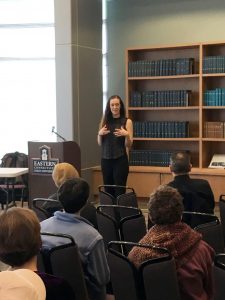- Apply
- Visit
- Request Info
- Give
Published on April 25, 2018
SUNY Old Westbury Professor Llana Barber visits Eastern
“White picket fences, apple orchards” and cookie cutter houses in the suburbs, cross an “unmarked barrier to find condemned mills and poverty in the city”. “How did the city get like this? How did it not affect the suburbs? Is segregation responsible?” These questions ran through my mind as SUNY Old Westbury Professor Llana Barber set the scene and placed me in the city of Lawrence, Massachusetts from 1945 to 2000.

In her recent visit to campus, Barber told the story of Dominican and Puerto Rican individuals migrating to the United States in search of what we know as the “American Dream.” However, what was initially expected from America was far from what they received.
These individuals initially settled in New York City, but the city was enduring an urban crisis: poverty and unemployment were rampant, and it was sometimes not safe. In search of a safer and more prosperous place to start their new lives, they migrated to the city of Lawrence, Massachusetts.
Lawrence was also, experiencing an urban crisis of its own due to what is known as the “suburb boom.” During this time Lawrence’s suburbs “expanded, doubling in size and individuals from the city moved into these suburban areas, causing the city to go through a downward spiral.”
The people of Lawrence were looking for a scapegoat for the city’s decline, someone to blame for the urban crisis, this scapegoat became Dominican and Puerto Rican settlers. These individuals were blamed for bringing poverty, crime, and welfare dependency to the city of Lawrence.
However, through the hard times, Dominican and Puerto Rican residents of Lawrence were determined to prove this narrative false. Instead they halted Lawrence’s decline: they increased the population of the city, they increased funding for schools, they saved local industries that were hanging by a thread and they insured that Hispanics had a voice in the community. It was an act of activism that revitalized the city, these individuals came together to transform the city of Lawrence.
Written by Casandra Rivera

